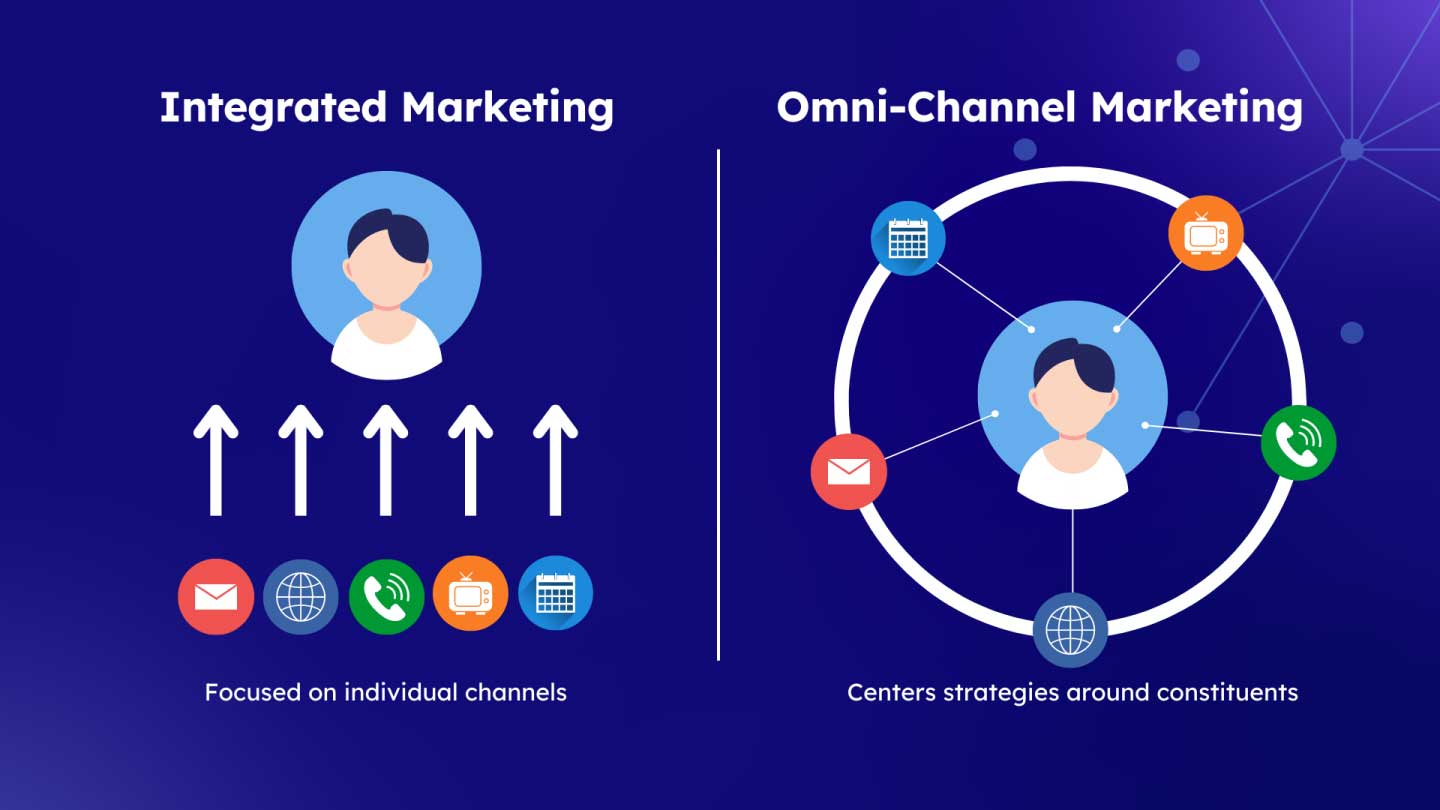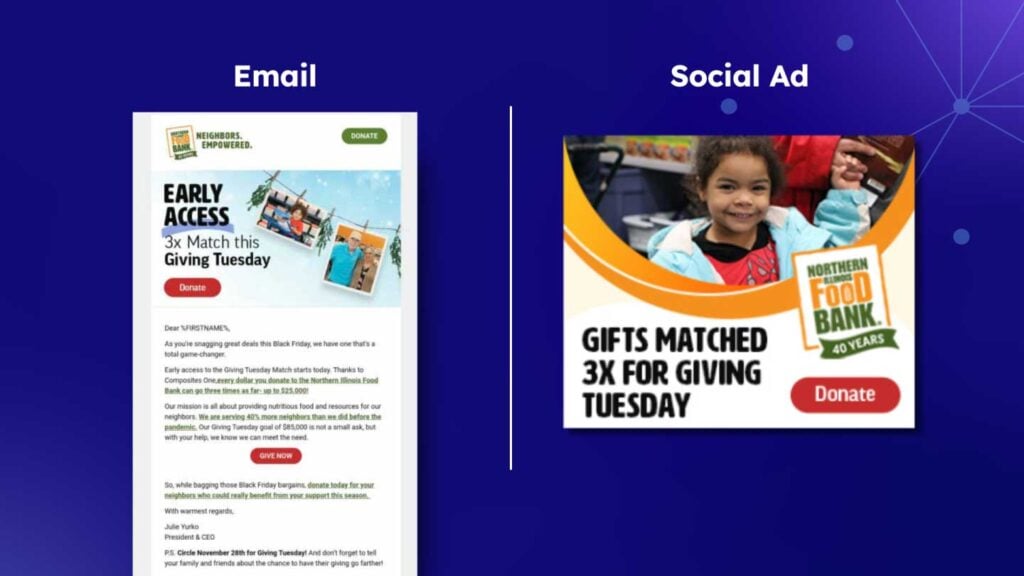How To Build a Framework for Omni-Channel Success

People have more options than ever for engaging with the brands they know and love. Social media, emails, texts, digital ads, videos, and even printed mailers offer opportunities to connect in more personal and customized ways.
The same goes for your nonprofit constituents. Through an omni-channel fundraising and marketing approach, you can forge deeper, longer-lasting relationships with those who support you.
But trying to be everywhere for all your donors and prospects can take time and effort—and being present in every channel isn’t always the best strategy. Here, we break down the mindset your organization should adopt to implement an omni-channel approach correctly. We’ll also share some expert tips to set you and your team up for success.
Integrated Marketing vs. Omni-Channel Marketing

Integrated marketing is often a precursor to omni-channel marketing. For instance, if you have a robust direct mail program, you might expand that into the digital space through emails. The programs could share copy and imagery for a consistent look and a cohesive campaign that plays to the strengths of each channel.
By contrast, omni-channel marketing zooms out and centers strategies on your constituents. It focuses on who you’re talking to, not the channels.
Say you want to attract new donors. What does that messaging and engagement strategy look like across channels? How will you speak with one voice? How will you prioritize what messages go where? With these details in mind, how will you leverage each channel’s strengths?
Omni-channel marketing relies on what each constituency needs most, and that mix will look different for each segment. Moreover, an omni-channel approach will vary for each organization, so there’s no one-size-fits-all framework.
Adopting omni-channel practices is a long game. It requires a mindset shift and a commitment from your organization to make structural and programmatic changes to do it well. While you might still have channel experts within your team, they need to come together to make decisions under a leader who can look at the big picture.
Components of an Omni-Channel Marketing Strategy
Adopting an omni-channel strategy doesn’t mean you have to be active and present on every channel. Instead, it makes the most of the channels and platforms you use within your budget.
Consistent messaging is essential, whether it’s a direct mail piece, email, digital ad, or organic social media post. Of course, the exact copy and imagery you use will vary depending on the channel. For instance, an email can contain more text and multiple links, while a Facebook ad requires snappier copy and a singular call to action (CTA). Both components work toward the same goal but in ways that take advantage of each channel’s strengths.

It’s also crucial to tailor your campaigns to different constituent groups. That means separate goals, CTAs, and experiences for your different donor levels — especially prospects.
The core idea of an omni-channel approach is to keep the messaging front and center while still leveraging the nuance in individual platforms and placement.
Overcoming Challenges of a Disconnected Donor Experience
Silos within your organization can seep into your messaging and confuse your supporters. Separate marketing, fundraising, membership, and event outreach give the impression that the teams within your nonprofit don’t speak to each other.
It’s important to remember that your constituents don’t know how your organization is structured internally. The best donor experience reflects this — it considers all the aspects of your organization, including the many ways constituents come to support you. Breaking down internal silos is vital to building experiences that honor those inroads and meet donors where they are.
Every touchpoint is significant, so use each message to put your donor relationship first. It’s not “we did this” but “you did this.” These tips can help you overcome disjointed communications for an omni-channel experience:
- Collect data about your constituents that enables you to understand as much about your constituents as possible. Craft messages that are most likely to resonate with their priorities.
- Create feedback loops that enable your audience to tell you about their experience with your communications. By paying attention to their input, you deepen loyalty and position yourself as their charity of choice.
- Be consistent. While you want to utilize each channel’s strengths, the copy, imagery, and overall theme of your campaign should be cohesive and have common CTAs.
- As you communicate with donors — and primarily as you collect their data — be sure to convey the value of this outreach. How do all these messages and requests improve their experience with your organization?
Internal Tips for Success
Internally, it’s essential to have an honest conversation about the channels you use. Are they effective? Is that where your followers are?
Don’t rush into an omni-channel approach because it “feels like the right move” or “everyone else is doing it.” If you’ve only ever focused on direct mail, for example, then leaping into multiple digital channels simultaneously will completely overwhelm your team. Instead, try a crawl-walk-run approach and take the next right step for your organization and audience.
In practice, you might add a complementary email campaign to your direct mail assets. Then, look at your data to see if adding a text campaign makes sense. Slowly build the foundation for the coordination and collaboration that will be essential for a well-run omni-channel strategy.
Your budget should reflect this shift. When multiple departments are working together to reach shared key performance indicators (KPIs), the lines between their budgets will get blurry. Buy-in from all levels of the organization is critical to bringing everyone to the table and creating a shared space that drives all teams toward the same goal.
To secure buy-in, ensure everyone is clear on each platform’s role in an omni-channel strategy. Outline precisely how you’ll measure success for each platform, tactic, and message, and have an upfront agreement on the KPIs that matter most.
Achieve Omni-channel Success with the Right Mindset
An omni-channel approach makes your organization more relevant, current, and able to adapt to ever-changing donor preferences in real time. More importantly, it enables you to build deeper loyalty with your supporters.
You know how critical it is to meet your constituents where they are. An omni-channel marketing and fundraising approach puts this into practice. But to be successful, your team needs the right structure and mindset. Bring team members from each department together and set a North Star goal to drive their efforts.
Above all, be flexible with your plan and budget so you can pivot in real time to meet your constituents’ evolving needs. The goal is fluidity.
The right partner can help your team build toward an omni-channel fundraising and marketing approach. Our Allegiance Group + Pursuant experts know how to tie each channel’s strengths into a cohesive campaign that puts your audience front and center. Reach out today to learn more and get started.
This blog is based on an episode of the Go Beyond Fundraising podcast. Listen to the complete conversation now.